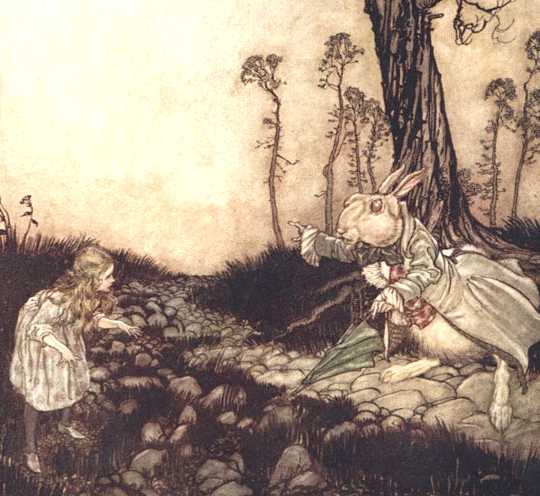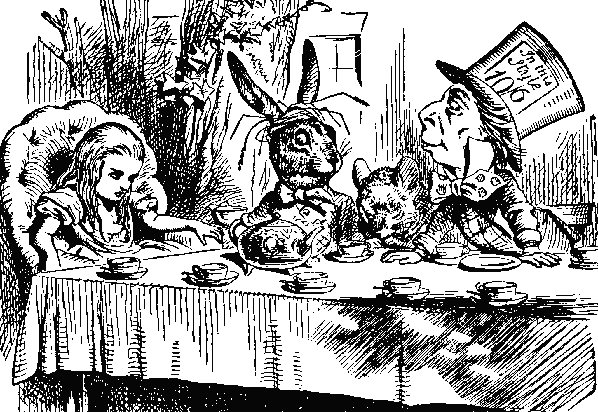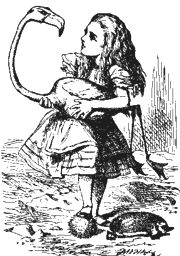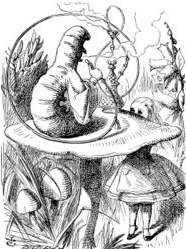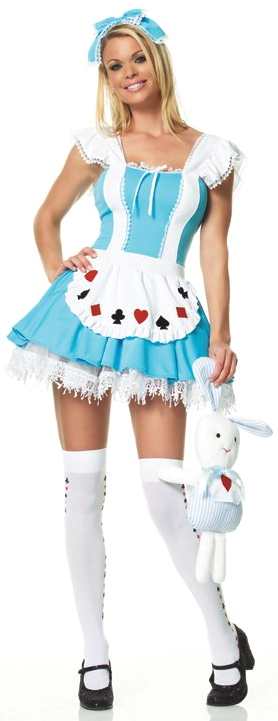|
ALICE IN WONDERLAND
|
|||||||||||||||||||||||||||||||||||||||||||||||||||||||||||||||||||||||||||||||
|
Arabian Tents offer you the chance to enjoy the flavour of this traditional story at your wedding reception or corporate event. Please see our Gallery for details, or speak with our event organiser, using the contacts page link above.
Alice's Adventures in Wonderland is a work of children's literature by the English mathematician and author, Reverend Charles Lutwidge Dodgson, written under the pseudonym Lewis Carroll. It tells the story of a girl named Alice who falls down a rabbit-hole into a fantasy realm populated by talking playing cards and anthropomorphic creatures.
The tale is fraught with satirical allusions to Dodgson's friends and to the lessons that British schoolchildren were expected to memorize. The Wonderland described in the tale plays with logic in ways that have made the story of lasting popularity with adults as well as children.
Alice in Wonderland illustration by Arthur Rackham
The book is often referred to by the abbreviated title Alice in Wonderland. This alternate title was popularized by the numerous film and television adaptations of the story produced over the years. Some printings of this title contain both Alice's Adventures in Wonderland and its sequel Through the Looking-Glass, and What Alice Found There.
History
Alice was first published on 4 July 1865, exactly three years after the Reverend Charles Lutwidge Dodgson and the Reverend Robinson Duckworth rowed in a boat up the River Thames with three little girls:
The journey had started at Folly Bridge near Oxford, England and ended five miles away in a village of Godstow. To while away time the Reverend Dodgson told the girls a story that, not so coincidentally, featured a bored little girl named Alice who goes looking for an adventure.
The girls loved it, and Alice Liddell asked Dodgson to write it down for her. He eventually did so and on 26 November 1864 gave Alice the manuscript of Alice's Adventures Under Ground. Some, including Martin Gardner, speculate there was an earlier version that was destroyed later by Dodgson himself when he printed a more elaborate copy by hand (Gardner, 1965), but there is no real evidence to support this.
According to Dodgson's diaries, in the spring of 1863 he gave the unfinished manuscript of Alice's Adventures Under Ground to his friend and mentor George MacDonald, whose children loved it. On MacDonald's advice, Dodgson decided to submit Alice for publication. Before he had even finished the manuscript for Alice Liddell he was already expanding the 18,000-word original to 35,000 words, most notably adding the episodes about the Cheshire Cat and the Mad Tea-Party. In 1865, Dodgson's tale was published as Alice's Adventures in Wonderland by "Lewis Carroll" with illustrations by John Tenniel. The first print run of 2,000 was shelved because Tenniel had objections over the print quality; a new edition, released in December of the same year but carrying an 1866 date, was quickly printed.
The entire print run sold out quickly. Alice was a publishing sensation, beloved by children and adults alike. Among its first avid readers were young Oscar Wilde and Queen Victoria. The book has never been out of print since. Alice's Adventures in Wonderland has been translated into over 50 languages, including Esperanto and Faroese. There have now been over a hundred editions of the book, as well as countless adaptations in other media, especially theatre and film (see below).
Publishing highlights
John Tenniel's illustration for "A Mad Tea-Party", 1865
Plot summary
A girl named Alice is bored while on a picnic with her older sister. She finds interest in a passing white rabbit, dressed in a waistcoat and muttering "Oh dear! Oh dear! I shall be too late!", whom she follows down a rabbit-hole, she finds herself floating down into a dream underworld. As she attempts to follow the rabbit, she has several adventures. She grows to gigantic size and shrinks to a fraction of her original height; meets a group of small animals stranded in a sea of her own previously shed tears; gets trapped in the rabbit's house when she enlarges herself again; meets a baby which changes into a pig, and a cat which disappears leaving only his smile behind; goes to a never-ending tea party; goes to the shore and meets a Gryphon and a Mock Turtle; and attends the trial of the Knave of Hearts, who has been accused of stealing tarts. Eventually, Alice wakes up back with her sister.
Major themes
Character allusions
The members of the boating party that first heard Carroll's tale all show up in Chapter 3 ("A Caucus-Race and a Long Tale") in one form or another. There is, of course, Alice herself, while Carroll, or Charles Dodgson, is caricatured as the Dodo. The Duck refers to Rev. Robinson Duckworth, the Lory to Lorina Liddell, and the Eaglet to Edith Liddell.
Bill the Lizard may be a play on the name of Benjamin Disraeli. One of Tenniel's illustrations in Through the Looking Glass depicts a caricature of Disraeli, wearing a paper hat, as a passenger on a train. The illustrations of the Lion and the Unicorn also bear a striking resemblance to Tenniel's Punch illustrations of Gladstone and Disraeli.
The Hatter is most likely a reference to Theophilus Carter, a furniture dealer known in Oxford for his unorthodox inventions. Tenniel apparently drew the Hatter to resemble Carter, on a suggestion of Carroll's.
The Dormouse tells a story about three little sisters named Elsie, Lacie, and Tillie. These are the Liddell sisters: Elsie is L.C. (Lorina Charlotte), Tillie is Edith (her family nickname is Matilda), and Lacie is an anagram of Alice.
The Mock Turtle speaks of a Drawling-master, "an old conger eel", that used to come once a week to teach "Drawling, Stretching, and Fainting in Coils". This is a reference to the art critic John Ruskin, who came once a week to the Liddell house to teach the children drawing, sketching, and painting in oils. (The children did, in fact, learn well; Alice Liddell, for one, produced a number of skilled watercolours.)
The Mock Turtle also sings "Turtle Soup". This is a parody of a song called "Star of the Evening, Beautiful Star", which was performed as a trio by Lorina, Alice and Edith Liddell for Lewis Carroll in the Liddell home during the same summer in which he first told the story of Alice's Adventures Under Ground (source: the diary of Lewis Carroll, August 1, 1862 entry).
The chief difficulty Alice found at first was in managing her flamingo"
Contents
Poems and songs
Tenniel's illustrations
John Tenniel's illustrations of Alice do not portray the real Alice Liddell, who had dark hair and a short fringe. Carroll sent Tenniel a photograph of Mary Hilton Babcock, another child-friend, but whether Tenniel actually used Babcock as his model is open to dispute.
Famous lines and expressions
The term "Wonderland", from the title, has entered the language and refers to a marvellous imaginary place, or else a real-world place that one sees as "like a dream come true!" It is widely referenced in popular culture— books and film (see below) and pop music. To note just one example, there is a book by the Japanese novelist Haruki Murakami entitled Hard-Boiled Wonderland and the End of the World.
"Down the Rabbit-Hole", the Chapter 1 title, has become a popular term for going into an adventure to the unknown. In the film The Matrix, Morpheus says to Neo: "I imagine that right now you're feeling a bit like Alice. Tumbling down the rabbit hole?" He also says, "You take the red pill and you stay in Wonderland and I show you how deep the rabbit-hole goes." In computer gaming, a "rabbit hole" may refer to the initiating element that drives the player to enter the game.
In an Alternate Reality Game, the rabbit hole is the first puzzle, or first event signalling the beginning.
A "white rabbit" has similar connotations, as a signal to the start of an adventure. In The Matrix, Neo's adventure begins after a message on his computer urges him to "Follow the white rabbit." Episodes of Star Trek and Lost also referenced the white rabbit. It is also, coincidentally or not, a street name for heroin.
In Chapter 6, the Cheshire Cat's disappearance prompts Alice to say one of her most memorable lines: "...a grin without a cat! It's the most curious thing I ever saw in all my life!" There is a French film called A Grin Without a Cat (1977), directed by Chris Marker.
In Chapter 7, the Hatter gives his famous riddle without an answer: "Why is a raven like a writing desk?" Although Carroll intended the riddle to have no solution, in a new preface to the 1896 edition of Alice, he proposes several answers: "Because it can produce a few notes, tho they are very flat; and it is nevar put with the wrong end in front!" Note the spelling of "never" as "nevar"—turning it into "raven" when inverted. This riddle later used to stump a character in Peter Beagle's The Last Unicorn. This spelling, however, was "corrected" in later editions to "never" and Carroll's pun was lost. Puzzle maven Sam Loyd offered these solutions: because the notes for which they are noted are not noted for being musical notes; Poe wrote on both; bills and tales are among their characteristics; because they both stand on their legs, conceal their steels (steals), and ought to be made to shut up. Many other answers are listed in The Annotated Alice.
Arguably the most famous quote is used when the Queen of Hearts screams "Off with her head!" at Alice (and everyone else she feels slightly annoyed with). Possibly Carroll here was echoing a scene in Shakespeare's Richard III (III, iv, 76) where Richard demands the execution of Lord Hastings, crying "Off with his head!"
Caterpillar using a hookah illustration by John Tenniel
Cinematic adaptations
Live Performance
Lewis Carroll's most famous work has also inspired numerous live performances, including plays, operas, ballets, and traditional English pantomimes. These works range from adaptions which are fairly faithful to the original book to those which use the story as a basis for new works. A good example of the latter is The Eighth Square, a murder mystery set in Wonderland. This goth-toned rock musical premiered in 2006 at the New Theatre Royal in Portsmouth, England.
With the immediate popularity of the book, it didn't take long for live performances to begin. One early example is Alice in Wonderland, a musical play by H. Saville Clark (book) and Walter Slaughter (music), which played in 1886 at the Prince of Wales Theatre in London.
Over the years, many notable people in the performing arts have been involved in "Alice" productions. One of the most well-known American productions was Joseph Papp's 1980 staging of Alice in Concert at the Public Theater in New York City. Elizabeth Swados wrote the book, lyrics, and music. Based on both Alice's Adventures in Wonderland and Through the Looking Glass, Papp and Swados had previously produced a version of it at the New York Shakespeare Festival. Meryl Streep played Alice, the White Queen, and Humpty Dumpty. The cast also included Debbie Allen, Michael Jeter, and Mark Linn-Baker. Performed on a bare stage with the actors in modern dress, the play is a loose adaption, with song styles ranging the globe.
Similarly, the 1992 operatic production Alice used both "Alice" books as its inspiration. However, it also employs scenes with Charles Dodgson, a young Alice Liddell, and an adult Alice Liddell, to frame the story. Paul Schmidt wrote the play, with Tom Waits and Kathleen Brennan writing the music. Although the original production in Hamburg, Germany, received only a small audience, Tom Waits released the songs as the album Alice in 2002, to much acclaim.
In addition to professional performances, school productions abound. Both high schools and colleges have staged numerous versions of Alice-inspired performances. The imaginative story and large number of characters are well-suited to such productions.
Criticism
The book, although broadly and continually received in a positive light, has also caught a large amount of derision for its strange and random tone (which is also the reason so many others like it). One of the best-known critics is fantasy writer Terry Pratchett, who has openly stated that he dislikes the book. L. Frank Baum, the author of the Wizard of Oz series, likewise disliked having his stories compared to Carroll's, saying his books were fantasy "with purpose" while the Alice stories were just "nonsense".
The book was banned in China in 1931 because the talking animals were considered blasphemous to Chinese beliefs.
Works influencedAlice and the rest of Wonderland continue to inspire or influence many other works of art to this day—sometimes indirectly; via the Disney movie, for example. The character of the plucky yet proper Alice has proven immensely popular and inspired similar heroines in literature and pop culture, many also named Alice in homage. it has also influenced many Japanese manga comics, most notable Miyuki-chan in Wonderland, by CLAMP. A recent comic book adaptation of Alice in Wonderland was also written and illustrated by Rod Espinosa and published by Antarctic Press. Using a blended style of Japanese Manga and Disney Animation, Rod Espinosa's New Alice in Wonderland returns to the original's roots and follows the Lewis Carroll classic very faithfully.
Culture and collectingAlice continues to be a cultural phenomenon today, spawning hundreds of collectors' items, websites, and works of art.
There is a vast Alice-collecting cottage industry, which has recently burgeoned due to the Internet. There are often more than 2500 items up for auction via eBay at any given time, from rare books to more recent commissioned art. Just about every kind of Alice merchandise imaginable is available, from clocks to earrings to pillow cases. They are not always easy to locate, but can often be found in so-called "Alice shops". In England, such shops include The Rabbit Hole in Llandudno and Alice's Shop in Oxford. Smaller ones can be found in Halton Cheshire and in Bournemouth where there is an Alice Theme Park. In the United States they include The White Rabbit in California. In fact, there is Alice merchandise in America that is not available elsewhere. One of these is a book called Sherlock Holmes and the Alice In Wonderland Murders.
Alice in Wonderland playing card outfit
LINKS and REFERENCE
Online texts
Illustrations
http://www.arabiantents.com
Accommodation guide:
|
|||||||||||||||||||||||||||||||||||||||||||||||||||||||||||||||||||||||||||||||
|
This website is Copyright © 2013 Kismet Girls Trust. All rights reserved. All other trademarks are hereby acknowledged. |
|||||||||||||||||||||||||||||||||||||||||||||||||||||||||||||||||||||||||||||||
